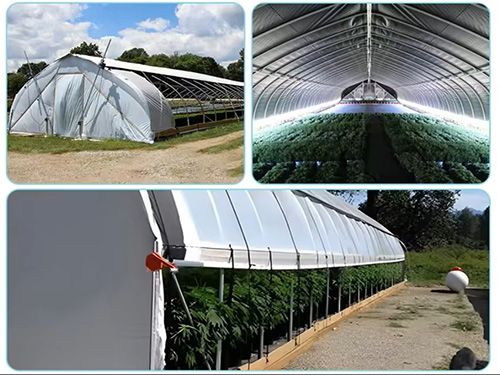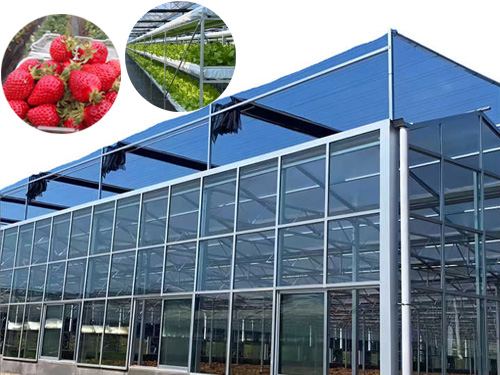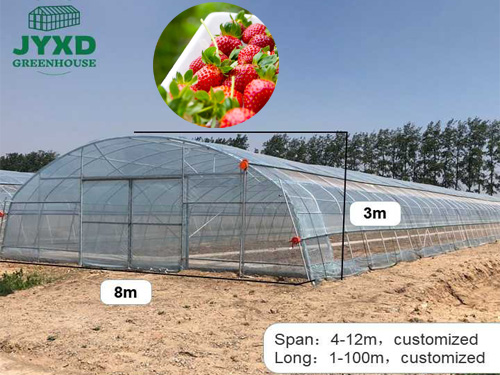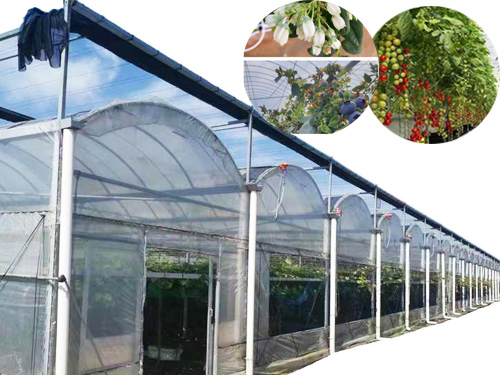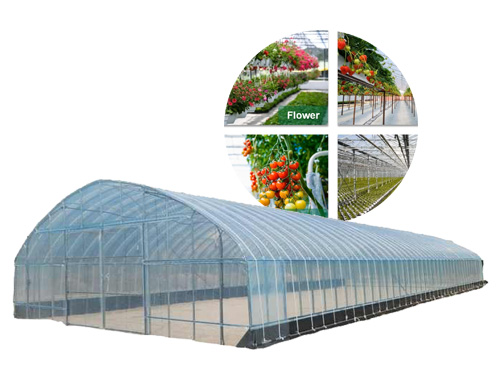NEWS DETAILS
NEWS INFORMATION
Subarctic Greenhouses: Growing and Managing Cold-Tolerant Crops
AUTHOR:jyxd-greenhouse DATE:2025-01-23 21:50:23 HITS:180
Subarctic regions, characterized by extremely cold winters and short growing seasons, present unique challenges for agriculture. However, subarctic greenhouses are increasingly being used to overcome these challenges and enable the cultivation of crops in environments that would otherwise be inhospitable. These greenhouses provide an environment where cold-tolerant crops can be grown and managed effectively, even in regions with freezing temperatures for much of the year. In this article, we will explore the role of subarctic greenhouses in agriculture, the types of cold-tolerant crops that can be grown, and best practices for managing these greenhouses.
Challenges of Growing in Subarctic Climates
The subarctic climate is defined by long, harsh winters with temperatures that can drop well below freezing. The short growing season, typically just a few months in summer, limits the time available for plants to grow and mature outdoors. Some of the major challenges faced by farmers in subarctic regions include:
1. Extreme Cold and Frost Risk
Subarctic regions experience cold temperatures for a significant portion of the year, with many areas enduring frost well into late spring and early fall. This makes outdoor cultivation impractical or impossible for many crops. Frost can also damage plants and reduce yields, creating uncertainty in food production.
2. Short Growing Season
With a growing season that may last only a few months, farmers must maximize crop growth during a limited window. Timing plantings and harvests to ensure crops reach maturity before the first frost is a critical challenge in subarctic agriculture.
3. Limited Sunlight
In subarctic regions, the length of daylight fluctuates dramatically throughout the year. During winter, the sun barely rises above the horizon, while in summer, the days can stretch for 20 hours or more. These long periods of darkness, followed by long days, can disrupt the natural growth cycles of many plants.
How Subarctic Greenhouses Address Agricultural Challenges
Subarctic greenhouses provide an ideal solution to the challenges posed by cold temperatures and short growing seasons. By creating a controlled environment, greenhouses offer several benefits that help mitigate the effects of the harsh subarctic climate:
1. Temperature Control
Subarctic greenhouses are designed to maintain a stable internal temperature that is conducive to plant growth. By trapping solar heat during the day and using supplemental heating systems during colder months, greenhouses protect crops from extreme cold and frost, allowing plants to grow even in freezing temperatures.
· Passive Solar Heating: Many subarctic greenhouses use passive solar heating, where the greenhouse is oriented to capture sunlight during the day. The materials used, such as double glazing or polycarbonate panels, help retain heat, reducing the need for additional heating systems.
· Supplemental Heating: For extreme cold, greenhouses may be equipped with supplementary heating systems, such as radiant floor heating or electric heaters, to ensure crops remain warm enough to grow.
2. Extended Growing Season
Subarctic greenhouses significantly extend the growing season, allowing crops to be planted earlier in the spring and harvested later in the fall. Some greenhouses can even facilitate year-round growing by maintaining a stable environment despite the changing weather outside.
· Early Planting: Greenhouses provide protection from the late spring frosts, allowing early planting of cold-tolerant crops, which can be harvested well before the outdoor frost arrives.
· Late Harvesting: With controlled temperatures, greenhouses enable the cultivation of crops until late fall or even winter, providing fresh produce during months when outdoor farming is not possible.
3. Optimizing Light Conditions
Greenhouses in subarctic regions are typically designed to capture as much sunlight as possible during the short summer months. The use of transparent materials like glass or polycarbonate helps maximize light intake, providing crops with the necessary energy to photosynthesize and grow. Additionally, artificial lighting systems, such as LED grow lights, can supplement natural light to ensure crops receive adequate light during the long winter months or overcast days.
· Adjustable Light Systems: Some greenhouses in subarctic regions use adjustable light systems that mimic natural sunlight patterns, helping plants maintain their circadian rhythms and grow at optimal rates.
· Reflective Materials: Reflective materials inside the greenhouse can help direct additional sunlight to plants, improving photosynthesis and accelerating growth.
Cold-Tolerant Crops for Subarctic Greenhouses
Subarctic greenhouses are particularly well-suited for growing cold-tolerant crops that can withstand lower temperatures and shorter growing seasons. The following crops are ideal candidates for cultivation in these environments:
1. Leafy Greens
Leafy greens, such as kale, spinach, lettuce, and arugula, are well-suited to cooler temperatures and can be grown in subarctic greenhouses year-round. These crops thrive in the cool, controlled environment of a greenhouse and can be harvested in less time compared to other crops.
2. Root Vegetables
Root vegetables, including carrots, radishes, potatoes, and turnips, are also ideal for subarctic greenhouses. These crops can tolerate colder soil temperatures and grow well in the controlled, warmer environment of a greenhouse. They also have relatively short growing periods, making them perfect for the limited growing season.
3. Brassicas
Brassicas, such as broccoli, cauliflower, cabbage, and Brussels sprouts, are hardy plants that can withstand cooler temperatures. They are well-suited to subarctic conditions and can be grown in greenhouses to protect them from extreme weather.
4. Herbs
Herbs like parsley, cilantro, thyme, and mint can also thrive in subarctic greenhouses. These plants often require less warmth than other crops and can be grown in smaller spaces within the greenhouse, making them ideal for greenhouse environments in cold climates.
5. Berries
Cold-tolerant berry varieties, including raspberries and strawberries, can be cultivated in subarctic greenhouses. While berries typically require more warmth than root vegetables or leafy greens, greenhouse environments can provide the necessary conditions for successful cultivation.
Best Practices for Managing Subarctic Greenhouses
Successfully growing cold-tolerant crops in subarctic greenhouses requires effective management practices to optimize crop growth and maintain a sustainable environment. Here are some best practices for managing these greenhouses:
1. Climate Monitoring and Control
It is essential to closely monitor temperature, humidity, and light levels within the greenhouse. Using automated climate control systems can help maintain optimal growing conditions, ensuring crops receive the right temperature, light, and moisture for healthy growth.
· Temperature Sensors: Installing temperature sensors in various parts of the greenhouse can help track temperature fluctuations and activate heating or cooling systems as needed.
· Humidity Control: Maintaining the right humidity levels is crucial for preventing disease and promoting healthy plant growth. Humidifiers or dehumidifiers can be used to manage moisture levels within the greenhouse.
2. Efficient Irrigation Systems
Watering needs in greenhouses are different from outdoor farming. In subarctic climates, where water may be limited during the winter, efficient irrigation systems are crucial. Drip irrigation or hydroponics systems can provide targeted watering while minimizing water waste.
3. Pest and Disease Management
While the controlled environment of a greenhouse reduces the risk of many outdoor pests, subarctic greenhouses still need to be carefully managed to prevent infestations. Using integrated pest management (IPM) strategies, such as natural predators or organic pest control methods, can help minimize the need for chemical pesticides.
Conclusion
Subarctic greenhouses offer a valuable solution for overcoming the challenges of farming in cold climates. By providing a controlled environment, these greenhouses allow farmers in subarctic regions to grow a variety of cold-tolerant crops throughout the year. With the ability to extend the growing season, protect crops from frost, and optimize light and temperature conditions, subarctic greenhouses are transforming agricultural possibilities in some of the harshest climates on Earth. By adopting best practices for greenhouse management, farmers can ensure a steady, sustainable supply of fresh produce in even the most challenging environments.
Hebei Juyou Xinda Greenhouse Facilities Co.,Ltd.
Copyright © 2024-2025 https://www.jyxd-greenhouse.com. All Rights Reserved Hebei Juyou Xinda Greenhouse Facilities Co.,Ltd.Copyright





 Current Location:
Current Location:


